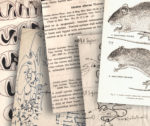Pequenos mamíferos em egagropilos de Tyto furcata em uma área de Floresta Ombrófila Mista no sul do Brasil
Débora da Silveira, Jorge J. Cherem, Patrícia HadlerA análise de egagropilos de aves de rapina, em particular de Tyto furcata, constitui uma importante técnica de amostragem de pequenos mamíferos, mas é ainda pouco explorada no Brasil. Neste trabalho realizamos o levantamento dos pequenos mamíferos presentes nos egagropilos de T. furcata coletados em uma área de Floresta Ombrófila Mista no estado de Santa Catarina, sul do Brasil. Foram registrados 364 indivíduos de 14 táxons das famílias Didelphidae, Cricetidae, Muridae e Caviidae. Oligoryzomys sp. foi o táxon mais frequente, correspondendo a 53,30% do total de indivíduos, seguido por Mus musculus (22,80%) e Calomys tener (14,84%), o que indica o predomínio de roedores de ambientes abertos e alterados. Espécies pouco amostradas com técnicas convencionais de captura, como Calomys tener, e espécies de hábitos florestais, como Sooretamys angouya e Thaptomys nigrita, também estiveram representadas na amostra. Os resultados obtidos corroboram a utilidade do método para o conhecimento dos pequenos mamíferos neotropicais.
Small mammals in pellets of Tyto furcata from a Mixed Ombrophilous Forest area in southern Brazil. The analysis of raptor pellets, in particular Tyto furcata, is an important sampling technique for small mammals, but it is still little exploited in Brazil. In this work we carried out a survey of the small mammals present in pellets of T. furcata collected in an area of Mixed Ombrophilous Forest in the state of Santa Catarina, southern Brazil. A total of 364 individuals from 14 taxa of the families Didelphidae, Cricetidae, Muridae and Caviidae were registered. Oligoryzomys sp. was the most frequent taxon, corresponding to 53.30% of the total of individuals, followed by Mus musculus (22.80%) and Calomys tener (14.84%), which indicates the predominance of rodents of open and disturbed environments. Species poorly sampled with standard capture techniques, such as Calomys tener, and forest species, such as Sooretamys angouya and Thaptomys nigrita, were also represented in the sample. The obtained results corroborate the usefulness of the method for the knowledge of Neotropical small mammals.
